Blue Jays 2011 : Is the turning point at hand .. at last?
Apr 2nd, 2011 | By Rob Sparrow | Category: Sporting Life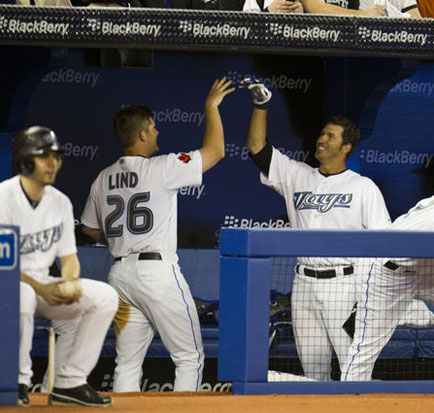
Toronto Blue Jays J.P. Arencibia celebrates his fourth inning two-run home run with teammate Adam Lind against the Minnesota Twins at the Rogers Centre, April 1, 2011. ANDREW WALLACE/TORONTO STAR.
Springtime has always brought with it an inherent calling to taking stock and to cleaning up. Both looking back on the damage wrought by the long harsh winter, and looking forward determining what is needed for the growing season. This important short interval sets the tone for what follows.
For the second straight year Blue Jays‘ general manager Alex Anthopoulos has his hands full with spring-cleaning. Last year it was the trade of long time pitching ace Roy Halladay to the Philadelphia Phillies that signalled a change in team philosophy; to restock the farm system with young prospects and let those young players learn on the job.
This year, the change was no different in magnitude, as the Blue Jays traded their most prominent player in the offseason, Vernon Wells. By unloading Vernon Wells and his albatross of a contract to the Anaheim Angeles the Jays admitted that his signing was a mistake.
Anthopoulos’ predecessor and former boss, J.P Ricciardi, signed Wells to a seven-year, $126 million extension after the 2006 season. A contract, that by his own admission he “never quite lived up to”, is now the Anaheim Angels problem.
Of course, the point of this trade wasn’t necessarily to make the 2011 Blue Jays a better team, but to give Toronto the financial flexibility to make meaningful improvements in the seasons to come. On that front, it could be a crucial turning point for the franchise in their efforts to climb back into contention in the powerful American League East. Using baseball parlance, it was the perfect example of “addition by subtraction.”
(And judging from the season’s April 1 home opener at a sold-out Rogers Centre – “Jays back to heavy-hitting ways in Opening Day blowout” … Toronto 13, Minnesota 3 – something may be working. The turning point may have already begun.)
New Leadership
The exodus of Wells and Halladay from the ball club has created somewhat of a vacuum in the leadership department. Much like any organization, those long-term established Jays had set the tone in regard to rules, rituals, work ethic, and expectations that others on the team followed. Now, those roles are being assumed by different people, one of whom is Jose Bautista.
By any measure, Bautista experienced one of the greatest hitting improvements in major league history last season. After hitting 13 home runs in 2009 he launched 54 in 2010, an unprecedented and unheard-of career turn for someone who had never hit more than 16 in a season in his first six years in the major leagues.
Blue Jay management rewarded his amazing 2010 with a long-term commitment, a five year contract worth $65 million. Now some rival executives will tell you the Jays were nuts to give Bautista all that money after a year in which he more than tripled his previous career high.  But clearly they see more than just the home runs when it comes to Jose Bautista.
The Blue Jays are indeed taking a risk : he is not likely to produce at his 2010 level. But in many ways they are also betting on the person, as Bautista has now become the defacto clubhouse leader whose presence, work ethic and commitment to winning is fast rubbing off on the other players. In the process Bautista is becoming a pivotal factor in the development of the Blue Jays’ other younger players. That, more than anything else, makes this signing a risk aligned with the overall team philosophy going forward.
This year also brings with it new leadership in the dugout, as legendary Cito Gaston has retired and rookie manager John Farrell takes over calling the shots. For the past four seasons Farrell was the pitching coach with the Red Sox, where he helped nurture a staff that included the likes of Josh Beckett and Jon Lester into one of baseball’s best. Prior to that, he spent time in the Cleveland organization in a role primarily of scouting and player development. From that front-office experience, Farrell learned to understand the importance of the draft and in the development of quality minor leaguers – the lifeblood of any organization.
To that end, Farrell has spent much of his time since joining the organization getting to know the players, especially the younger ones. Farrell’s enthusiasm towards the players has also been attested to by Ricky Romero, who has recalled a spring training bullpen session that the new manager watched with interest : “You could see him getting excited … He’s brought that to the team himself, just by the way he goes about his business.” That enthusiasm, energy, and the ability to see things with a beginner’s mind align congruently with the organization’s new philosophy. Another that’s reason this a compelling team to root for this 2011 season.
Good Solid Core
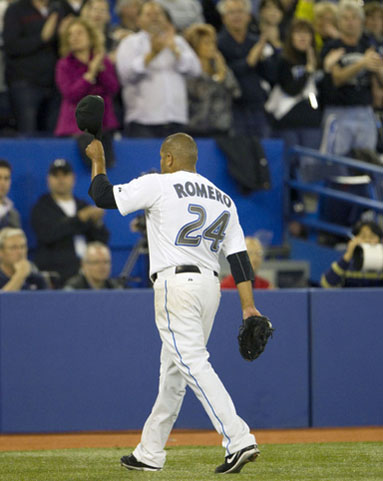
Starting pitcher Ricky Romero tips his cap to fans after leaving in the seventh inning of opening home game, in which he did a brilliant job.
The Blue Jays can also boast a good solid core group of young players, both on the mound and at the plate, that are about to enter their prime. The youthful pitching staff was a pleasant surprise in 2010, led by Ricky Romero, who solidified himself as the Blue Jay Number #1 starter. The 26-year-old Romero has won 27 games over the last two seasons, underscored by a 3.73 ERA, pretty stellar numbers for any pitcher in the competitive American League East.
The starting staff’s big three is also composed of young lefthander Bret Cecil, who came out of nowhere to lead the team in wins with 15 and Seattle castoff Brandon Morrow. Morrow, a former reliever turned starter, turned out to be a major find for Anthopoulos. Dominate at times, this hard throwing righty developed into a big time starter with his near perfect game against the Rays, while compiling the highest strikeout rate per nine in the American league.
Yet for the Jays to make up for some of the offense that has left through trades, they will need bounce-back years from two players who form the offense component of the team’s solid core –Â Adam Lind and Aaron Hill.
After a huge 2009 (35 homers, 114 RBI, .932 OPS) Adam Lind took an equally huge step backward in 2010 (23 HR, 72 RBI, .712 OPS) : a massive disappointment for Jays’ fans and one of the more puzzling declines in the American League. He simply has to bounce back in 2011 if this lineup is to be productive.
As for Aaron Hill, you can pick on him all you want for his career-low .205 average a year ago, but in many ways it can be blamed on his struggles with an injury. Hill said it was “mentally tough” for him to deal with a lingering hamstring injury he suffered early in the season. Prior to last season, Hill boasted a career .285 average and despite the low average last year still bashed 26 homers. Hill claims he is back at 100% but lingering aches continued to plague him in spring training, making him a question mark for 2011.
One other young Jay poised for a breakout year is Travis Snider. To me, he is the real personnel wildcard heading into 2011 and beyond. Few people remember that Snider is only 23-years old, and was once the highly touted prospect and gem of the farm system. Could this finally be the season he puts it all together? The potential is there for him to take the next step. He could be the player that the next wave of Jays’ youngsters look to lead them over the next few years.
New Jays
Speaking of next wave of youthful Jays, it has been a long time since the Blue Jays had this many talented prospects in their farm system. These are the players that the Blue Jays hope to tie their wagon to. And here are the key players who will take us into the teens and beyond:
Kyle Drabek: This top prospect acquired in the Roy Halladay trade with Philadelphia is the only rookie pitcher to open the season in an American League starting rotation. Last year’s Eastern League Pitcher of the Year (Double-A) had a nice September debut in 2010. It served as a stepping stone to a spot in the starting rotation for 2011. His bread and butter has always been one of the best curveballs you’ll see, along with an above-average fastball. He is listed as the #12 overall prospect on Major League Baseball’s (MLB) Top 50 list (No. 3 right-handed pitcher) and is a potential AL Rookie of the Year candidate. This 22-year-old right-hander will be given every chance to succeed with the Jays in 2011.
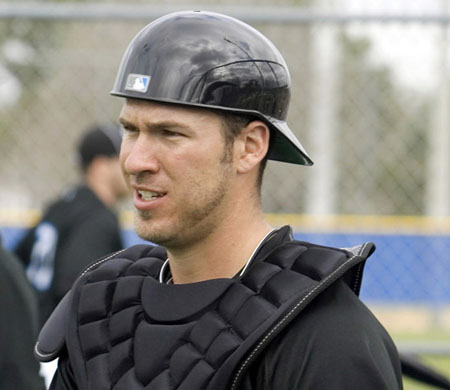
Catcher J.P. Arencibia had a taste of playing for the Jays last year, and now he’s the man behind the plate full time.
J.P. Arencibia: The Blue Jays are ready to hand the everyday catching duties to their 2007 first-round Draft pick. He was named Pacific Coast League MVP (Triple-A) last season and hit two memorable Home Runs in his MLB debut against the Rays last August at the Rogers Centre. Arencibia was named No. 48 on the Top MLP Prospect list (No. 6 among catchers), has legitimate power and should be an excellent run producer. He’s has defensive ability behind the plate and has shown to be a good leader, but he’ll more than likely be pegged as an offensive-minded backstop. Don’t worry if Arencibia’s numbers don’t look great off the bat, most rookie catchers struggle to hit as they learn the defensive intricacies of the majors. This kid can definitely hit and is a major building block for the future.
Brett Lawrie: The prized Canadian prospect from Langley, B.C. impressed during spring training at third base, having come over in the Shaun Marcum deal in the off-season. He not only made a positive impression with his bat, but he also showed some new-found maturity. A tireless worker, Lawrie should make the transition to third and have enough offense for the position. Although the 21-year-old was sent down last week and will open the season at triple-A Las Vegas, he showed he may not be as far away from the majors as his age and experience suggest. He should hit for average and some power to go along with some speed. And if Lawrie’s transition to third base continues to be as quick and smooth in Vegas as it was in camp, he could be pushing for a promotion this season.
Anthony Gose: The apple of general manager Alex Anthopoulos’ eye is viewed as a long-term project, another two to three years away. A 2008 Draft pick of the Philadelphia Phillies, he was included in the three-team deal that sent Roy Oswalt from the Astros to the Phillies, Brett Wallace from the Blue Jays to the Astros, and Gose, technically, from the Phillies to the Astros to the Blue Jays. There’s no question about Gose’s speed (he stole 76 bases in his first full season with the Phillies) and with the Blue Jays committed to playing a more up-tempo kind of game, his skills should fit perfectly once he gets to the big-league. He’s still raw in some aspects of the game, but made a very good impression in big league camp this spring, going 9-for-10 in stolen base attempts. Gose is a plus defender in centre field, and as he learns to be more selective and read pitchers better on the bases, he should turn into an outstanding lead-off man. He’ll move up to Double-A to start the year.
Adeiny Hechavarria: The Blue Jays made a splash in the International Free Agency market by signing this Cuban shortstop to a big deal last April. There’s no doubt about Hechavarria’s ability with the glove. Scouts who saw him during his brief Arizona Fall League stay last fall buzzed about watching him take infield with fellow Cuban Jose Iglesias of the Red Sox. The question is how much he’ll hit. He did bat .273 in Double-A last year and has good speed. That and his glove work should make him a shortstop in the big leagues for a long time. Depending on his development, expect to see him later this year in Toronto as a September call-up.
Travis d’Arnaud: A highly regarded catching prospect, d’Arnaud might be a better all-around catcher than Arencibia when all is said and done. He came over with Kyle Drabek in the Roy Halladay deal and missed time in his first season with a back problem. He has an outstanding arm behind the plate and is more than agile enough to be a stellar defender. He also has a quick bat and should have decent power, even if he hasn’t put up huge numbers just yet. He should get a bump up to Double-A to start 2011.
Zach Stewart: A former relief pitcher, Stewart went back to starting full-time in his first full season with the Blue Jay organization in 2010. Stewart had some moderate success, forming a nice one-two punch with Kyle Drabek in New Hampshire (Double-A), finishing eighth in the Eastern League with a 3.63 ERA. His fastball-slider combination have many thinking that he could potentially be a the closer of the future. But how far his change-up develops will determine his ultimate role. He’s still a starter for now and will deal with the challenge of pitching in Triple-A Las Vegas in 2011.
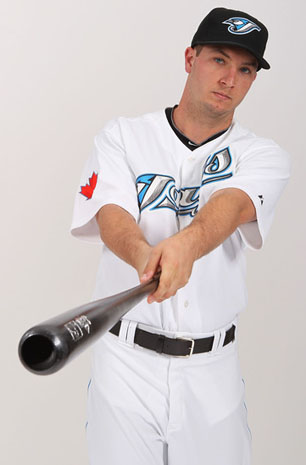
David Cooper in spring training – at Florida Auto Exchange Stadium on February 20, 2011 in Dunedin, Florida.
David Cooper: Cooper certainly opened eyes this spring with John Farrell wondering out loud “how a guy with his sweet swing was ever a .250 hitter in the minors.” Cooper is just 24-years-old, and has completed a second season at New Hampshire (Double-A), where he hit .257 while doubling his home run total of the year before to 20. He was selected 17th overall in the 2008 draft, and that was a lot of pressure for a young player who started out slowly in his career. He will begin the year in Las Vegas. But depending on how Adam Lind progresses defensively at first base, Cooper a good economical insurance policy for 2011.
Eric Thames:Â In another year, he might have made the top five in Blue Jay prospects, but with the addition of talent via the draft and from trades, he gets pushed a little out of the spotlight. Still, the 2008 seventh-round Draft pick hit 27 homers and drove in 104 runs in the Double-A Eastern League a year ago, and profiles as a solid, power-hitting corner outfielder. After getting a lot of time in big league games this spring, he’ll be heading to Triple-A waiting for that first call for an extra outfielder.
Economics of Sport
General Manager Alex Anthopoulos has, time and again, said that money isn’t an issue as far as team owner Rogers Communications is concerned. His mantra is to get younger, get more athletic and acquire as many prospects and players with a high upside as he can. That said, the move toward younger cheaper players will also have to be bought by the Blue Jays’ faithful.
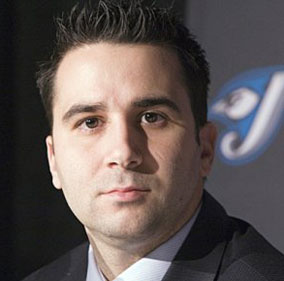
Alex Anthopoulos, the still new enough Blue Jays General Manager who was born in Montreal and has a degree in economics from McMaster University in Hamilton, ON, continues to make people enthusiastic about the team and its prospects.
Last years attendance at Jays’ games dropped over 20% – from 1.876 million in 2009 to 1.495 million in 2010. That significant loss at the gate was partially offset by an estimated payroll drop from $80 million in 2009 to $62 million in 2010 (a number they should also be around for 2011). The Blue Jays have fallen from their once mighty perch in their glory years of being one of the most valuable franchises in baseball.
According to Forbes magazine, The Toronto Blue Jays are the fourth least valuable franchise in Major League Baseball. In its annual rankings, the Jays are estimated to be worth $337 million (US), well behind their two “big market” rivals in the American League East; the New York Yankees ($1.7 billion) and Boston Red Sox ($912 million), the two richest teams in the sport.
Moreover, the Jays’ estimated value is nearly $200 million less than the $523 million average for an MLB franchise. Ye it still is $200 million more than the $137 million Rogers Communications paid for the franchise in a 2000 fire sale. This has led Rogers to kicking the tires on acquiring the Ontario Teachers’ Pension Plan’s 66% stake in Maple Leaf Sports and Entertainment (MLSE) — a move that could change the landscape of sport in the Canadian marketplace (more on that in a future post).
Final Analysis – 2011 and into the teens …
Swinging hard helped the Jays to 85 wins last year. But those 85 wins were only good enough for fourth place in the American League East. And it won’t be any easier this year; The Yankees are still the Yankees, and able to outspend all comers; The Red Sox have retooled with proven stars Carl Crawford and Adrian Gonzales entering the prime of their career. The Rays continue to have a core of young players and solid management that will make them a tough team to play against. Even the Orioles will be no push over in the new Buck Shoewalter regime.
Overall, the Blue Jays’ new manager John Farrell is stressing that in the post-steroid era consistent pitching and solid defence are paramount. And he is promising that the Blue Jays won’t be as one-dimensional on the attack as last season – when they relied on home runs for run production. He still expects to score runs with the long ball, but he also wants his team to force the issue and be more active on the base paths. Stealing bases, hit and runs, bunting men over – whatever it takes to be more aggressive and score runs.
So what about 2011? As mentioned above, there are prospects in the pipeline and someone else is paying Vernon Wells for his particular brand of off-field decency and on-field adequacy. With this in mind, the season is already a win. The Blue Jays are content dealing with expected growing pains and are looking to prepare themselves to develop a strong home-grown core for years to come. But many of the prospects are not ready yet, and neither are the Jays for that matter.
It thus appears that 2011 will be a year of transition, as the organization prepares and grooms some of its minor league prospects – to hopefully turn them into full fledged contenders in 2012. The Jays are on a path that may see them take a step backward in order to reach the goal of consistently competing for a World Championship. Yet sometimes the journey to reach the summit takes you to places that seem at that moment farther away from your goal. Patience and perseverance should then be practised by the Jays’ faithful, in a year that should see them win as many as they lose.
Hope though may be on the way in the form of an expanding playoff structure for 2012. Major League Baseball is considering adding one additional wild card playoff team for each league. That could be a life-line for those other teams who have to compete with the Yankees and Red Sox in the sports world’s toughest division. Perhaps iot will also become a life-line that levels the playing field, and finally rewards the patience of Blue Jays’ fans, by delivering October baseball once again north of the border.
Robert Sparrow is a Toronto marketing analyst and noted local authority on the sporting life.
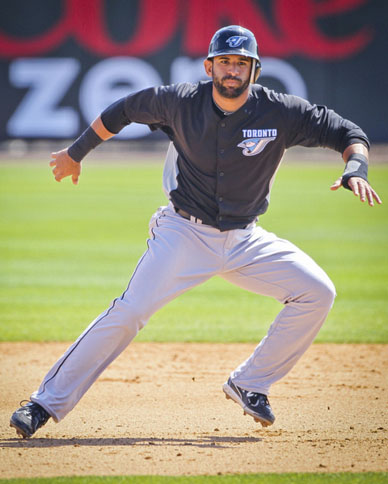
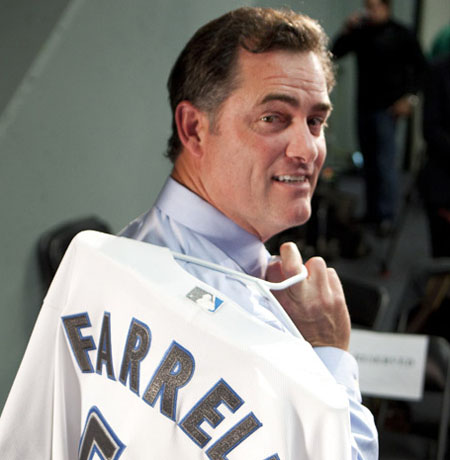


Very in depth article. Shove this piece in your pipe and smoke it Rosenthal.
Reading this article a month into the season proves out the fact that Mr. Sparrow knows what he’s talking about. The investment in Jose Bautista (leading the league in batting average, on base percentage AND home runs), getting out from under the Vernon Wells contract (he’s off to a brutal start with the Angels), the aggressive coaching of John Farrell (I was at Rogers Centre to see the squeeze play vs. Rivera and the Yankees… wow!)… I could go on.
I’d love to read more of Mr. Sparrow’s work.
Dave Wilson…. Wilton, CT